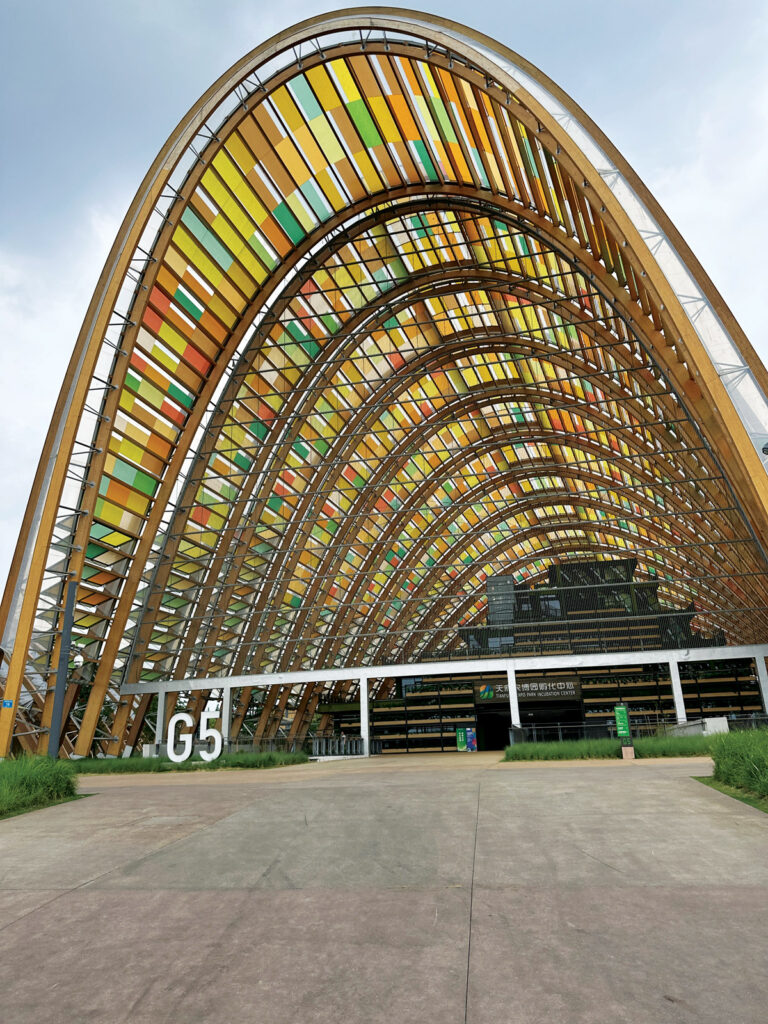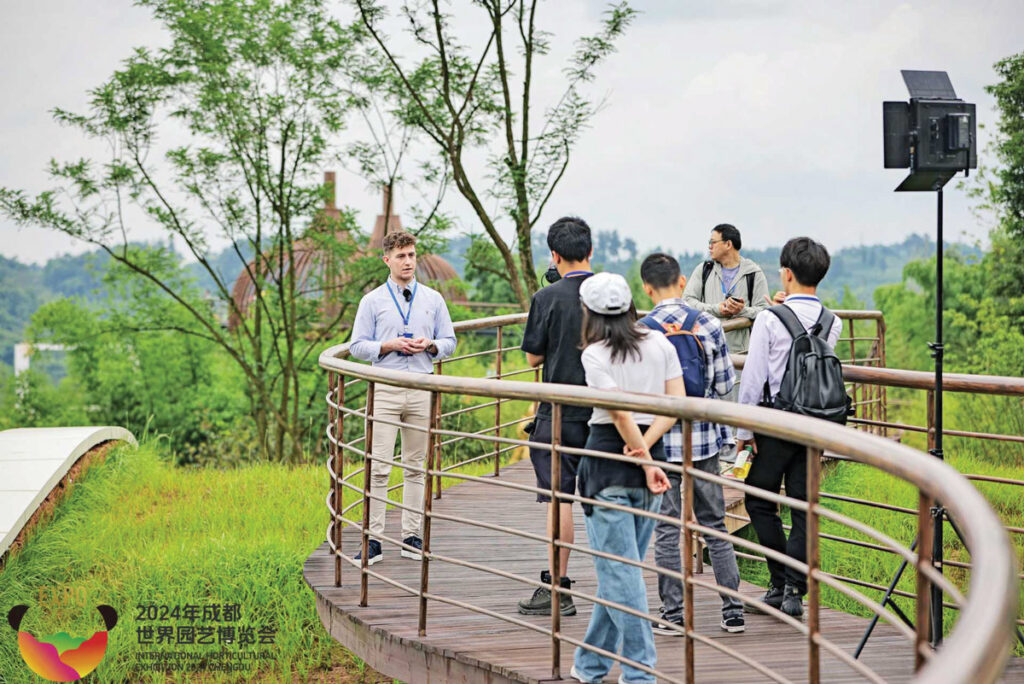Spanning an area of 242 hectares, the International Association of Horticultural Producers (AIPH) approved International Horticultural Exhibition 2024 is currently underway in Chengdu, China, where it will run until 24 October.
The theme of this year’s expo is ‘Beautiful life in the park city’. The 186-day event aims to promote exchanges and mutual learnings through the presentation of advancements in gardening, horticulture and agriculture, and to highlight the importance of sustainability underpinning these sectors.
The exhibition consists of a main venue in the Chengdu Eastern New Area, along with a number of sub venues located in different areas of the region, each with their own unique characteristics, but all with one common theme – sustainability. Event organisers pride themselves on having implemented a sustainable development action plan to ensure that the expo is guided by principles of environmental friendliness, cost-effectiveness, and inclusiveness to all. The concept of ‘green, low-carbon, sustainable, shared’ has been put into effect, bringing visitors a unique experience.
I was fortunate enough to be part of a group of journalists and industry specialists from around the world invited to experience the event over the June Bank Holiday weekend. Over the course of the trip, I visited the Main Venue, along with the Agri Expo Park and Longmen Mountain Biodiversity Park.
MAIN VENUE: EASTERN NEW AREA OF CHENGDU
The main venue is located close to the Jiangxi River Ecological Corridor in the Eastern New Area of Chengdu. Showcased here is a vast range of flowers, plants and horticultural techniques from around the world, contained within 113 meticulously laid out gardens.
Each of the 113 gardens represent a different country or region. Plants and architectural styles native to each country or region are on show within each individual garden, making for an immersive experience which is almost like travelling around the world in a day.
Proudly perched near the centre of the expo, is the Irish garden – titled ‘Garden of Fair Fingal’. (Fingal being represented in the name due to its twinning with the Chengdu region). The garden’s theme is ‘Emerald Island’. Undulating natural grass slopes, limestone rock and patches of meadow flowers are used to create an island landscape reminiscent of the west coast of Ireland. The design also contains cultural elements, such as shamrocks and triskele engravings, to reflect Irish identity.
Other gardens that stood out included the French ‘Montpellier’ palace style garden, and the Asian gardens, mainly due to the impressive structures, features and planting schemes used throughout.
This main venue is three years old but feels like it has been there for a lifetime. The layout and attention to detail put into every aspect makes it feel like a different world. It is maintained and kept in pristine condition by a workforce of over 700 staff, with each individual clearly taking great pride in what they and the event organisers have collectively achieved.
Amazingly, the area has retained approximately 80 per cent of its original landscape, along with hundreds of native plants that had been growing on site, long before the plans for the expo were put in place. On the sustainability front, rainwater is harvested throughout the site and used to help meet irrigation demands. A fleet of electric vehicles take care of all transport requirements and solar panels provide the power for night time illumination. Organisers explained that they hope for the venue to act as a template for the Chengdu region’s goals of green development and carbon neutrality.
Upon completion of the expo, it is intended for the site to remain open to the public for tourism, events and educational purposes.
AGRI-EXPO
Day two began with a trip to the Tianfu Agriculture Expo Park. This sub venue is 113 hectares in size. It places a spotlight on the agricultural area in the Chinese province of Sichuan and aims to promote and revitalise it.
Upon entering the venue, visitors are greeted with a giant timber structure featuring five vaulted sections housing an agricultural museum, multiple conference areas, exhibition spaces and smart agriculture demonstrations. Built on an area covering 7.5 hectares, the structure has earned the accolade of the largest timber construction in Asia, and is certainly one of the largest in the world. The curved roofs were specially designed to resonate with the nearby hills and mountains, which have been vital for agricultural production in the region, providing shelter and water for animal and crop production. The buildings also serve a practical function, with the large roof surface area ideal for harvesting rainfall for reuse in crop irrigation.
Members of the public are invited to attend agricultural experience activities which are organised throughout different farming seasons of the year. This allows visitors to get a firsthand experience of agriculture in the area and enables them to connect with how the food they consume is produced. They are also given the opportunity to learn about the site’s numerous sustainable, smart agriculture projects and trails that are ongoing.
The museum on site details the rich 5,000-year history of agriculture in the region and brings visitors on an in-depth interactive journey through time, from when the first settlers began farming to the present day.
Also present at this sub-venue is a large-scale blueberry farm, used as a demonstration and research base. Here, sustainable growing practices and novel techniques have been implemented to increase productivity and consumer engagement. The blueberry farm boasts a state-of-the-art tissue culture and virus detection laboratory, a seedling breeding centre, and a blueberry planting demonstration area. It has the capacity to produce 400,000 high-quality seedlings annually.
Blueberries require acidic soil, which is not commonly found in this area. Therefore, all plants are grown in pots, allowing for easier control over crop requirements such as soil pH and nutrient application. The technologies used allow for accurate monitoring of plant growth and help ensure that resources such as water, nutrients and fertilisers are used responsibly.
The farm is open to the public to come and pick their own blueberries, which has proven to be very popular amongst locals. It also sells its produce through online stores and supermarkets. The farm manager commented that China is a net importer of blueberries and that there is huge potential for growth in the sector, especially through the use of smart agriculture technologies.

THE WONDERFUL CHARM OF BIODIVERSITY PROTECTION
Next up was a trip to the Longmen Biodiversity Expo Park. Nestled on the outskirts of a traditional Chinese village close to the Longmen Mountain range, this sub venue focuses on the importance of biodiversity. The aim here is to promote the ‘wonderful charm of biodiversity protection’ and to showcase how different plant and animal species co-exist in the area through harmonious relationships.
Upon arrival, attendees are encouraged to stroll through the state-of-the-art visitor centre to become familiar with the history and biodiverse nature of the area. The centre is divided up into different sections. In the Species Diversity Conservation Hall, specimens and models of rare animals – such as wild giant pandas, Sichuan golden monkeys, takins, red pandas and green-tailed pheasants – are on display. Also on show is an emporium of traditional Chinese natural herbal remedies created from plants commonly found in the surrounding landscape.
In a separate area, the geography and geology of the region is explored in exhibitions detailing how the natural landscape was formed and continues to be shaped over time.
In 2008, the area was hit by an earthquake with an estimated magnitude of 8.0, causing considerable damage. Through the use of virtual reality simulators, visitors can experience what it would be like travelling in a car in the mountainous region when an earthquake strikes. Another virtual reality simulator brings visitors on an immersive boat journey through the region, which helps give a better understanding and appreciation for plants and wildlife in the area. A short walk away is the outdoor exhibition site, consisting of numerous viewpoints overlooking areas of significance and a high rise walkway through dense bamboo forest.

Through the use of virtual reality simulators, visitors can experience what it would be like travelling in a car in the mountainous region when an earthquake strikes
As it approaches the halfway stage of its 6-month run, the impressive International Horticultural Exhibition 2024 is on course to meet its target of five million visitors over the course of the event. Until the end of October this year, the expo will continue to inspire and increase public awareness with regard to the importance of sustainability in horticulture, agriculture and biodiversity. ✽
 HUGH LARKIN is an alumnus of University College Dublin, where he studied Agri-Environmental Sciences. He is from Co Monaghan, works as an environmental consultant for CLW Environmental, and has a particular interest in agri-environmental sustainability. Email: hugh@clw.ie.
HUGH LARKIN is an alumnus of University College Dublin, where he studied Agri-Environmental Sciences. He is from Co Monaghan, works as an environmental consultant for CLW Environmental, and has a particular interest in agri-environmental sustainability. Email: hugh@clw.ie.




